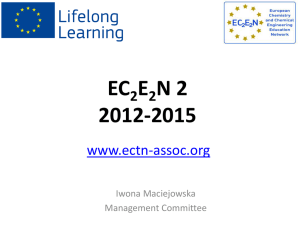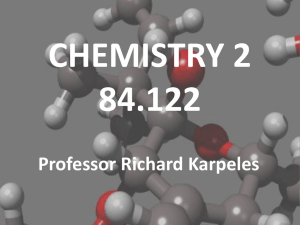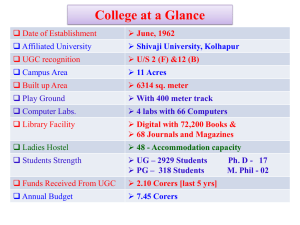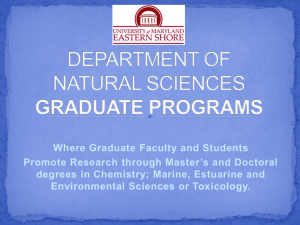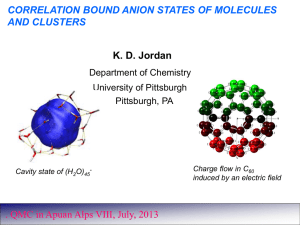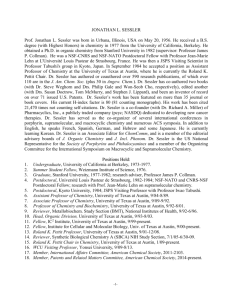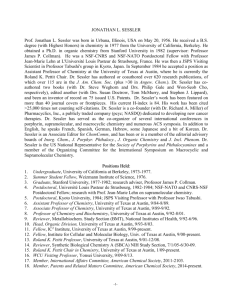Pyrrolic Receptors: From Sensors and Recognition to Self
advertisement
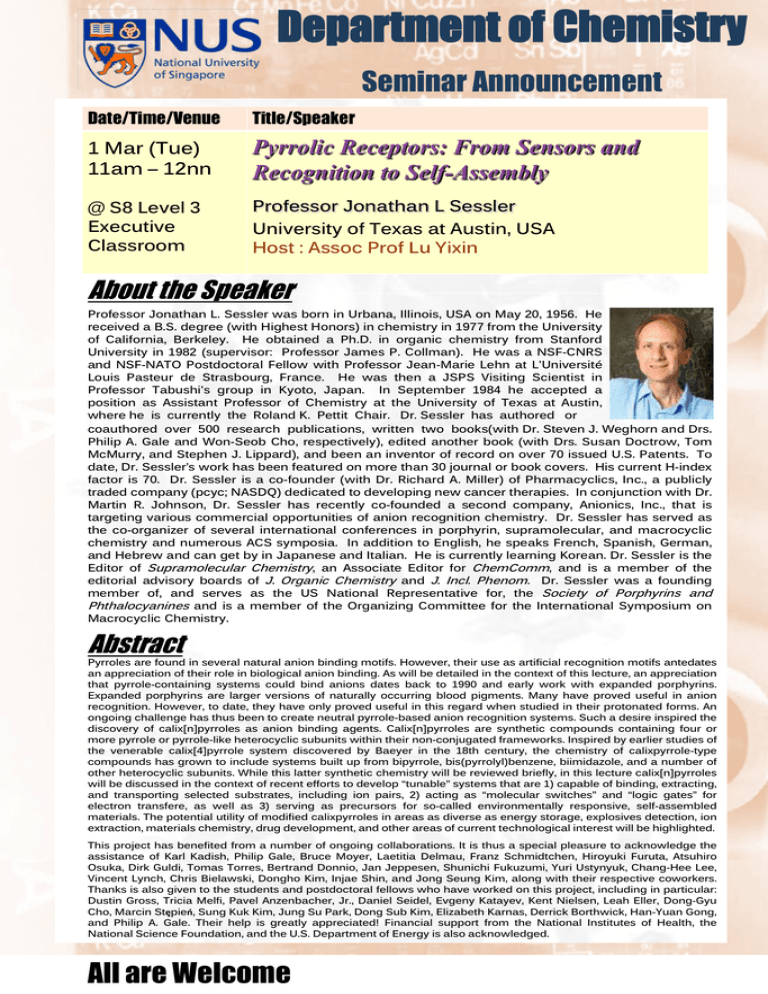
Department of Chemistry Seminar Announcement Date/Time/Venue Title/Speaker 1 Mar (Tue) 11am – 12nn Pyrrolic Receptors: From Sensors and Recognition to Self-Assembly @ S8 Level 3 Executive Classroom Professor Jonathan L Sessler University of Texas at Austin, USA Host : Assoc Prof Lu Yixin About the Speaker Professor Jonathan L. Sessler was born in Urbana, Illinois, USA on May 20, 1956. He received a B.S. degree (with Highest Honors) in chemistry in 1977 from the University of California, Berkeley. He obtained a Ph.D. in organic chemistry from Stanford University in 1982 (supervisor: Professor James P. Collman). He was a NSF-CNRS and NSF-NATO Postdoctoral Fellow with Professor Jean-Marie Lehn at L'Université Louis Pasteur de Strasbourg, France. He was then a JSPS Visiting Scientist in Professor Tabushi's group in Kyoto, Japan. In September 1984 he accepted a position as Assistant Professor of Chemistry at the University of Texas at Austin, where he is currently the Roland K. Pettit Chair. Dr. Sessler has authored or coauthored over 500 research publications, written two books(with Dr. Steven J. Weghorn and Drs. Philip A. Gale and Won-Seob Cho, respectively), edited another book (with Drs. Susan Doctrow, Tom McMurry, and Stephen J. Lippard), and been an inventor of record on over 70 issued U.S. Patents. To date, Dr. Sessler’s work has been featured on more than 30 journal or book covers. His current H-index factor is 70. Dr. Sessler is a co-founder (with Dr. Richard A. Miller) of Pharmacyclics, Inc., a publicly traded company (pcyc; NASDQ) dedicated to developing new cancer therapies. In conjunction with Dr. Martin R. Johnson, Dr. Sessler has recently co-founded a second company, Anionics, Inc., that is targeting various commercial opportunities of anion recognition chemistry. Dr. Sessler has served as the co-organizer of several international conferences in porphyrin, supramolecular, and macrocyclic chemistry and numerous ACS symposia. In addition to English, he speaks French, Spanish, German, and Hebrew and can get by in Japanese and Italian. He is currently learning Korean. Dr. Sessler is the Editor of Supramolecular Chemistry, an Associate Editor for ChemComm, and is a member of the editorial advisory boards of J. Organic Chemistry and J. Incl. Phenom. Dr. Sessler was a founding member of, and serves as the US National Representative for, the Society of Porphyrins and Phthalocyanines and is a member of the Organizing Committee for the International Symposium on Macrocyclic Chemistry. Abstract Pyrroles are found in several natural anion binding motifs. However, their use as artificial recognition motifs antedates an appreciation of their role in biological anion binding. As will be detailed in the context of this lecture, an appreciation that pyrrole-containing systems could bind anions dates back to 1990 and early work with expanded porphyrins. Expanded porphyrins are larger versions of naturally occurring blood pigments. Many have proved useful in anion recognition. However, to date, they have only proved useful in this regard when studied in their protonated forms. An ongoing challenge has thus been to create neutral pyrrole-based anion recognition systems. Such a desire inspired the discovery of calix[n]pyrroles as anion binding agents. Calix[n]pyrroles are synthetic compounds containing four or more pyrrole or pyrrole-like heterocyclic subunits within their non-conjugated frameworks. Inspired by earlier studies of the venerable calix[4]pyrrole system discovered by Baeyer in the 18th century, the chemistry of calixpyrrole-type compounds has grown to include systems built up from bipyrrole, bis(pyrrolyl)benzene, biimidazole, and a number of other heterocyclic subunits. While this latter synthetic chemistry will be reviewed briefly, in this lecture calix[n]pyrroles will be discussed in the context of recent efforts to develop “tunable” systems that are 1) capable of binding, extracting, and transporting selected substrates, including ion pairs, 2) acting as “molecular switches” and “logic gates” for electron transfere, as well as 3) serving as precursors for so-called environmentally responsive, self-assembled materials. The potential utility of modified calixpyrroles in areas as diverse as energy storage, explosives detection, ion extraction, materials chemistry, drug development, and other areas of current technological interest will be highlighted. This project has benefited from a number of ongoing collaborations. It is thus a special pleasure to acknowledge the assistance of Karl Kadish, Philip Gale, Bruce Moyer, Laetitia Delmau, Franz Schmidtchen, Hiroyuki Furuta, Atsuhiro Osuka, Dirk Guldi, Tomas Torres, Bertrand Donnio, Jan Jeppesen, Shunichi Fukuzumi, Yuri Ustynyuk, Chang-Hee Lee, Vincent Lynch, Chris Bielawski, Dongho Kim, Injae Shin, and Jong Seung Kim, along with their respective coworkers. Thanks is also given to the students and postdoctoral fellows who have worked on this project, including in particular: Dustin Gross, Tricia Melfi, Pavel Anzenbacher, Jr., Daniel Seidel, Evgeny Katayev, Kent Nielsen, Leah Eller, Dong-Gyu Cho, Marcin Stępień, Sung Kuk Kim, Jung Su Park, Dong Sub Kim, Elizabeth Karnas, Derrick Borthwick, Han-Yuan Gong, and Philip A. Gale. Their help is greatly appreciated! Financial support from the National Institutes of Health, the National Science Foundation, and the U.S. Department of Energy is also acknowledged. All are Welcome



